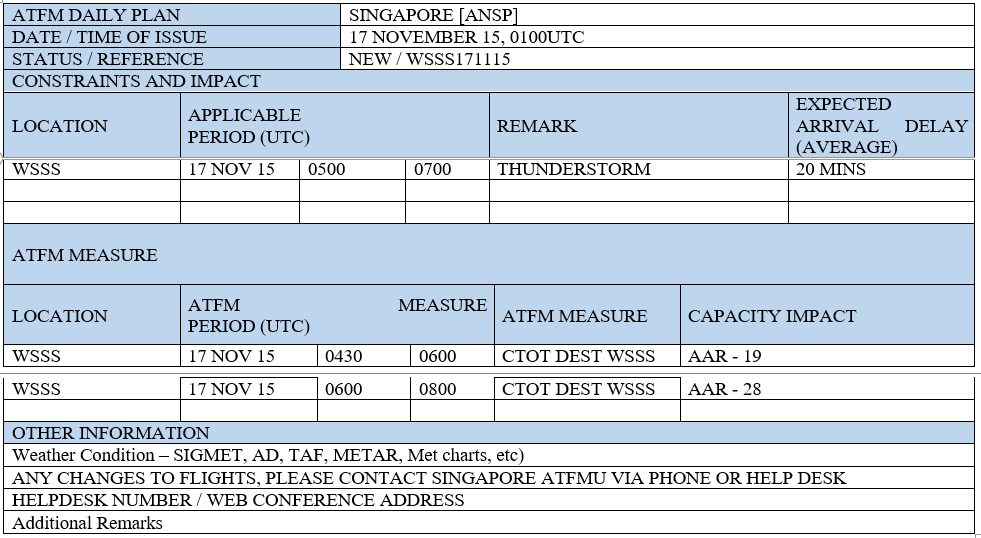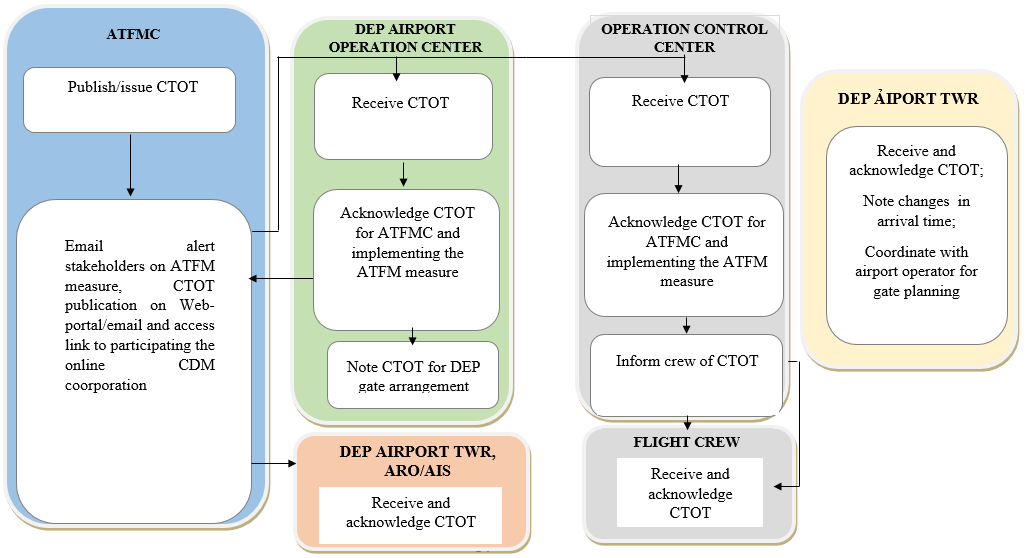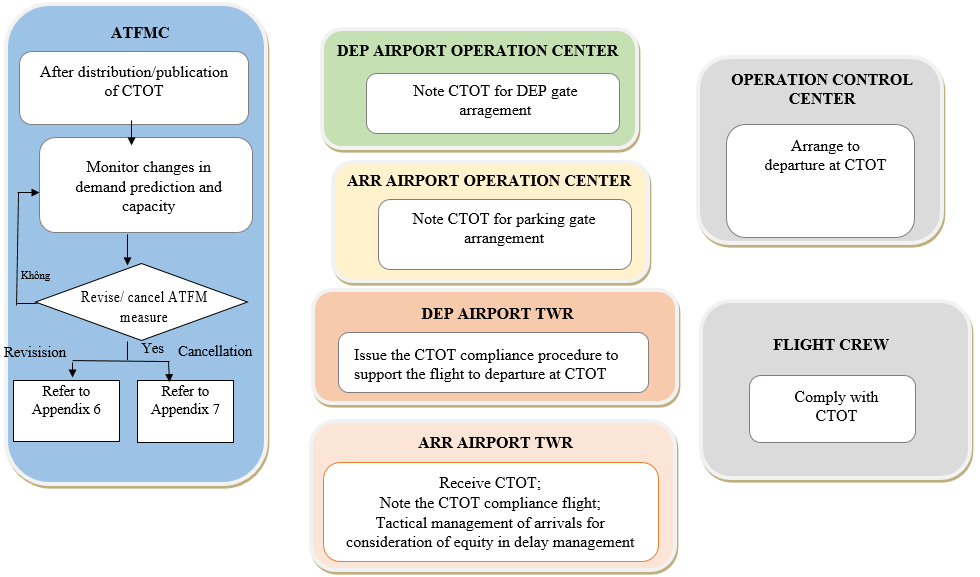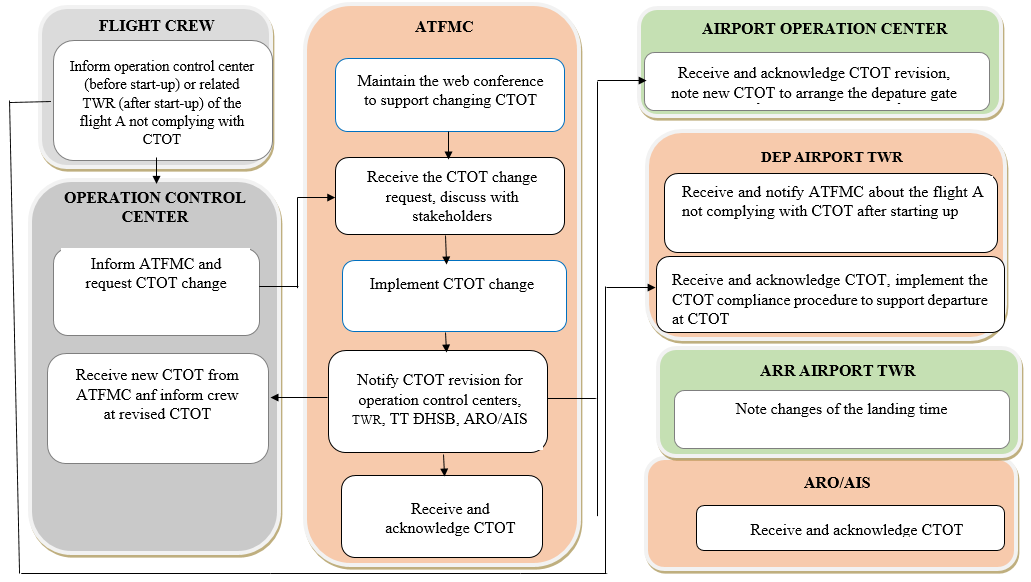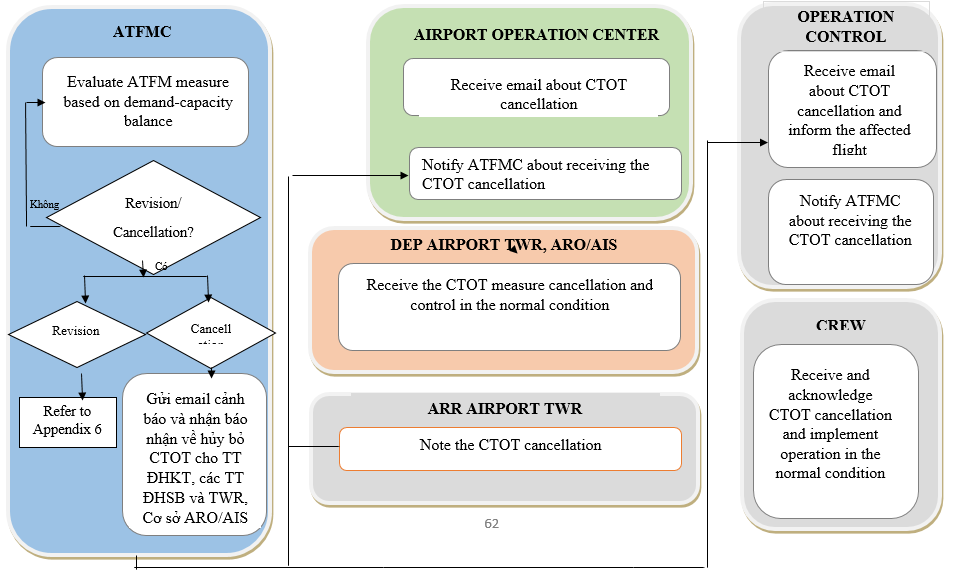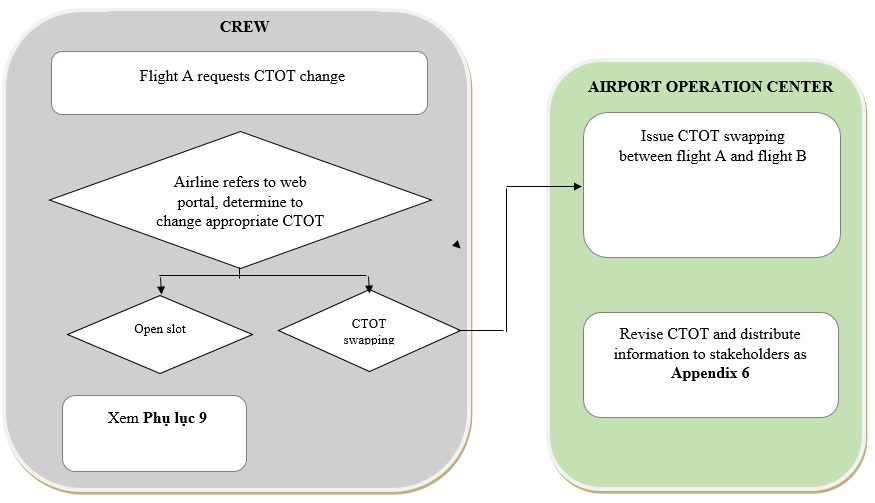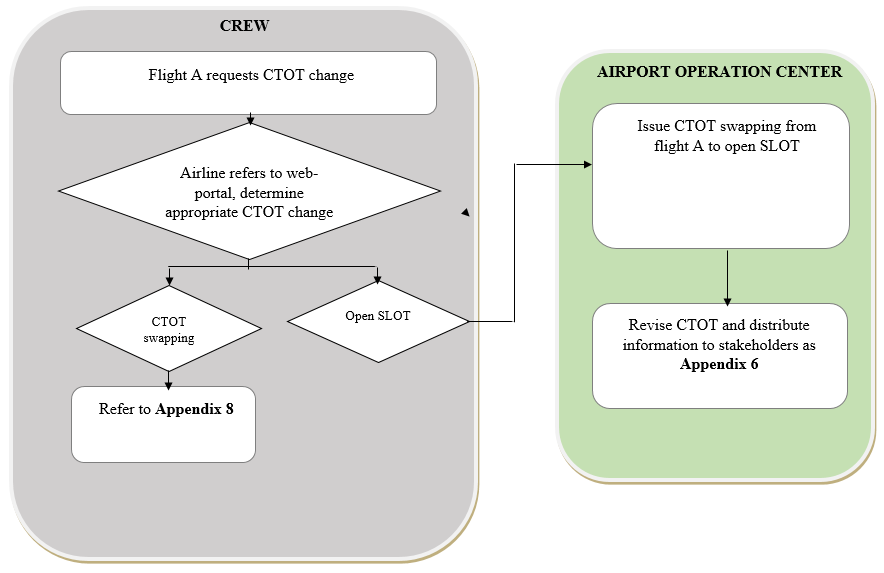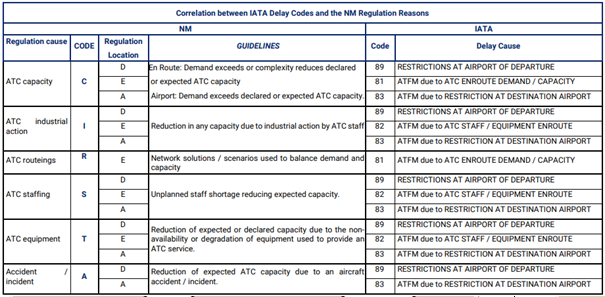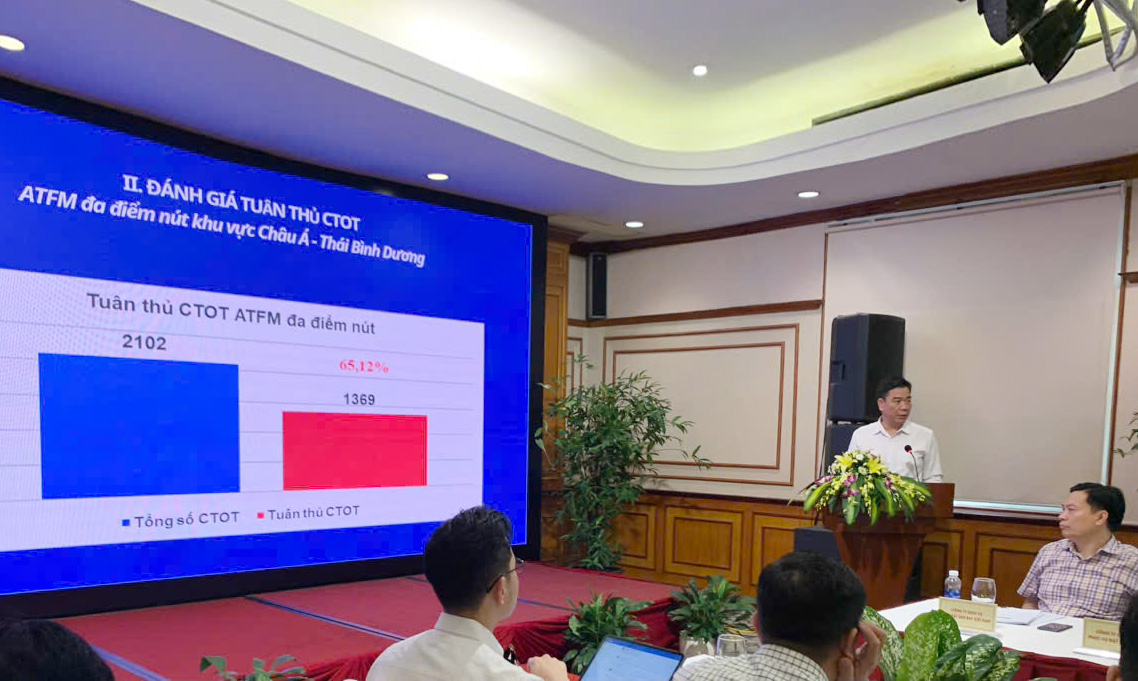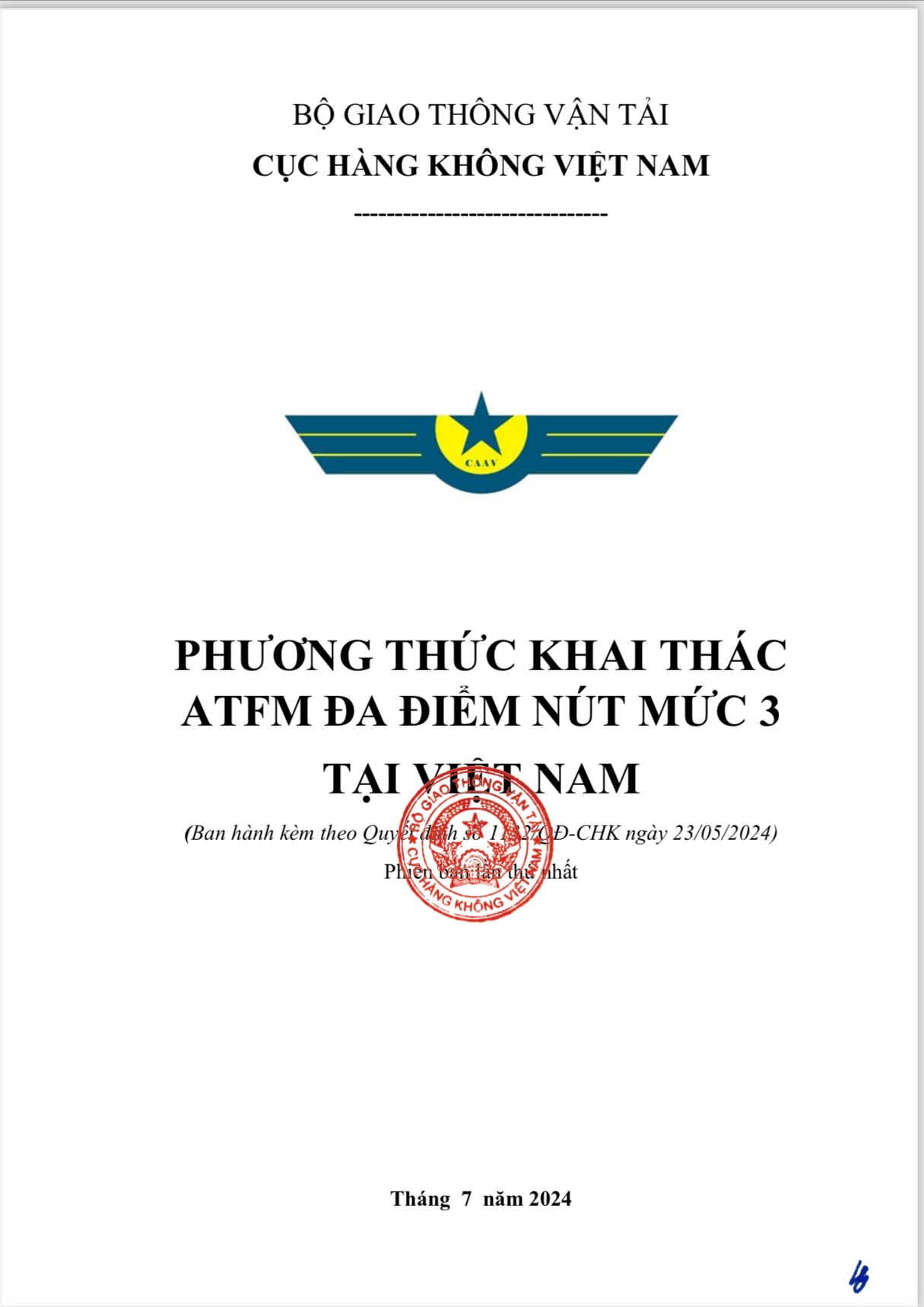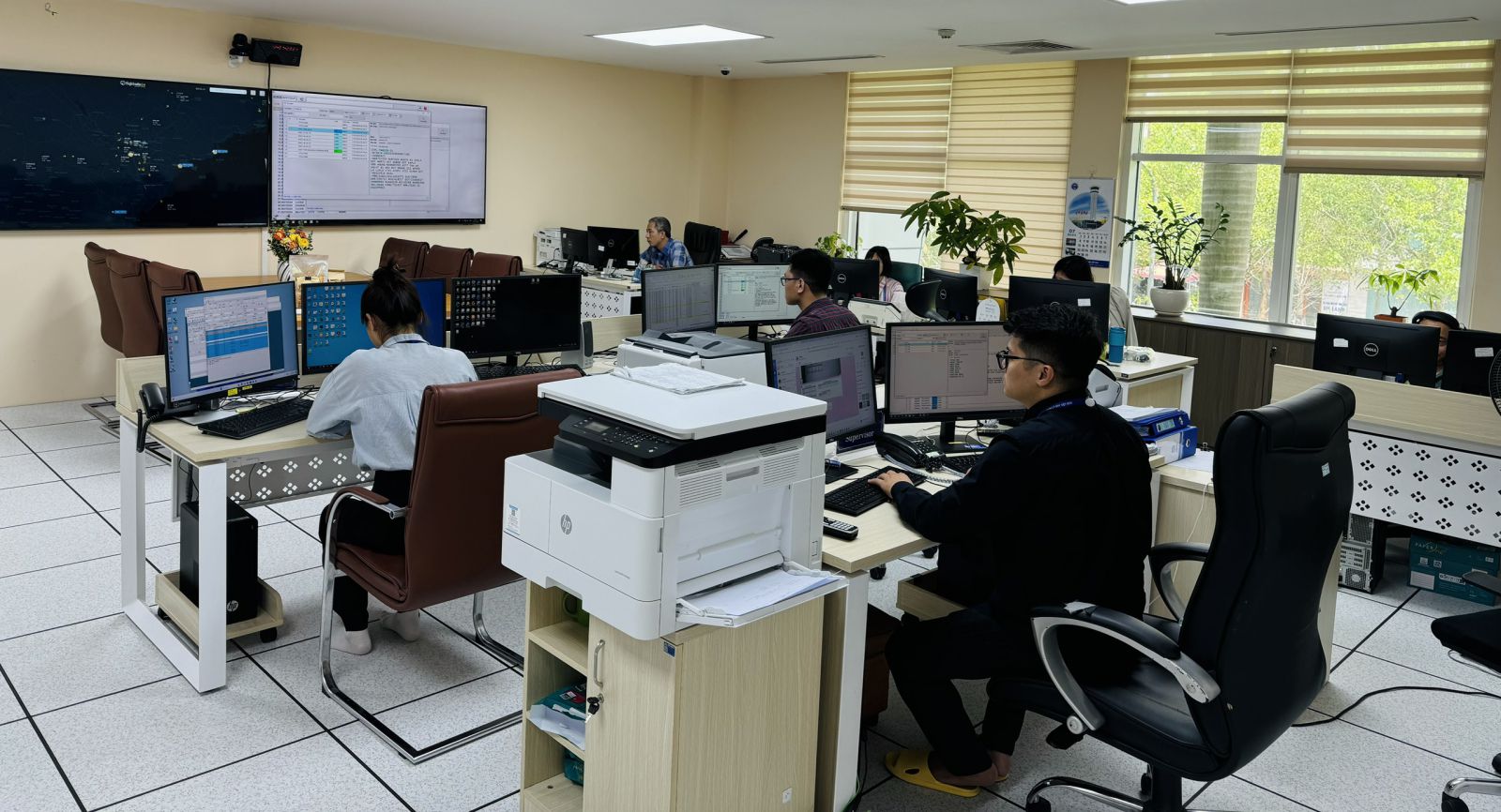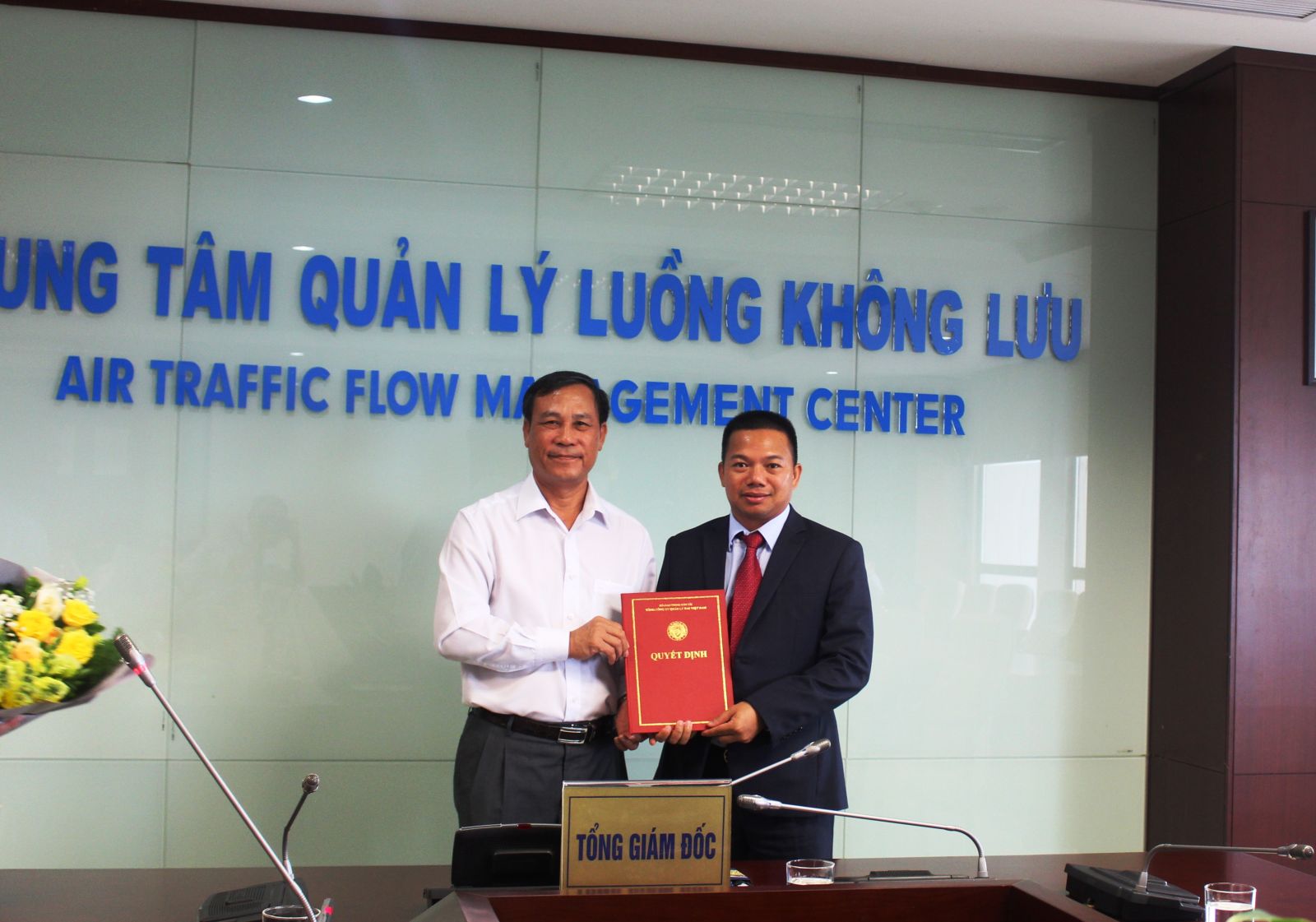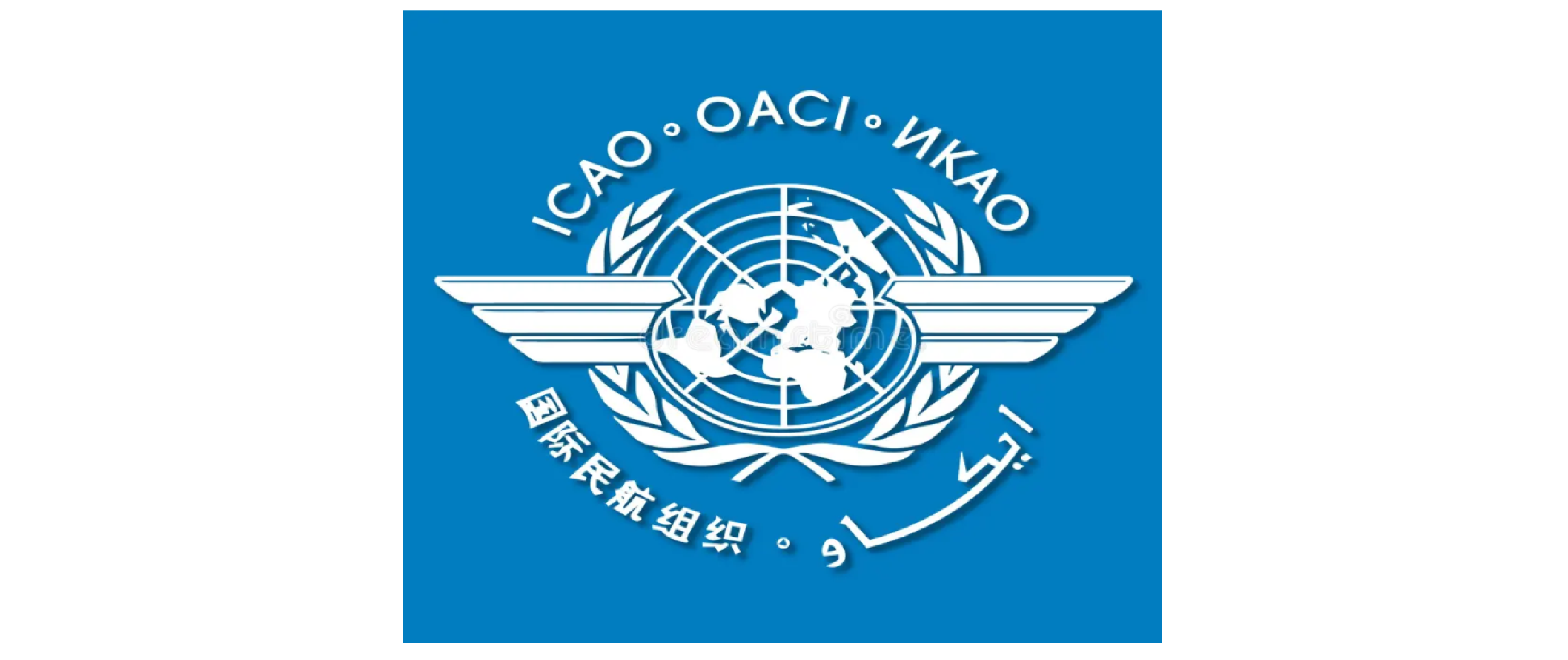Vietnam achieves level 3 participation in the Asia-Pacific Cross Border Multi Nodal ATFM Colaboration ENGLISH VERSION
LEVEL 3 MULTI- NODAL ATFM OPERATION PROCEDURE
CONTENT
2. Scope and objects of application. 4
3. Terms and abbreviations explannation. 5
4. Legal basis and reference documents. 7
II. Concept of operation procedure. 8
1. The Asia- Pacific cross-border multi-nodal ATFM Collaboration Project... 8
2. Distributed Multi-Nodal ATFM Network Participation Level 8
3.1. General ATFM terminologies. 8
3.2. ATFM terminologies for Flight Event Time. 9
3.3. Flight Event Time Terminology mapped to specific flight event time and status 10
4. General information about Air Traffic Flow Management Center 10
5. ATFMC Scope of Operations 11
6. Units involved in the Level 3 ATFM Operation in Viet Nam.. 11
7. Stakeholder’s Responsibilities. 12
7.2 NORATS, SORATS, MIRATS. 13
7.3 Aeronautical Information Service Center 13
7.4. Aeronautical Meteorological Center 14
7.5. Airports Corporation of Vietnam - Airport operations center/room; 14
8. Exemption of Flights from ATFM Measure(s) 16
10. Conditions for applying ATFM level 3. 17
11. GDP operation procedure. 18
11.1. Principles of calculating and consulting CTOT. 18
11.2. CTOT Calculation Methodology by the Air Traffic Flow Advisory System (ATFAS) 19
11.3. Submit FPL and send ATS messages 19
11.4. Participate in online conferences (CDM Web Conference) 20
11.5. Determine the possibility of affecting the operational capacity. 20
11.6. CTOT delivery and compliance. 21
11.7. Revision/cancellation of CTOT. 24
11.9. CTOT information delivery methods 26
11.10. CTOT compliance management 26
11.11. Operation of the technical equipment system.. 27
11.13. Storage of related information and messages. 27
III. IMPLEMENTATION ORGANIZATION.. 27
I. INTRODUCTION
1. Purpose
- To effectively participate in the Asia-Pacific cross-border multi-nodal ATFM Collaboration and ensure smooth air traffic flow throughout Vietnam and the region.
- To achieve synchronous and unified implementation across participating units, promoting smooth air traffic flow in Vietnam when being Level 3 multi-nodal ATFM.
2. Scope and objects of application
2.1. Scope of application
This document is applicable for all stakeholders involved in the Level 3 multi- nodal ATFM (indicative measure Calculated Take-Off Time (CTOT)) for aircraft operating at Vietnamese airports, including international and domestic flights.
2.2. Applicable subjects
This procedure applies to the following entities:
- Vietnam Air Traffic Management Corporation:
+ Air Traffic Flow Management Center;
+ Northern Air Traffic Management Company (NORATS);
+ Middle Air Traffic Management Company (MIRATS);
+ Southern Air Traffic Management Company (SORATS);
+ Aeronautical Information Service Center (AIS Center);
+ Aeronautical Meteorology Center (AMC);
- Airlines:
+ Operation Control Center (Domestic Airlines);
+ Airline representative (Foreign airline);
- Enterprises supporting for flight planning procedures.
- Airports Corporation of Vietnam:
+ Airport Operation Center/Room;
- Van Don International Airport.
- Other stakeholders participate in implementing this procedure.
3. Terms and abbreviations explanation
3.1. Terms
- ATFM node: includes air navigation service providers (ANSPs), airport operators, and involved airlines.
- Multi-nodal ATFM Collaboration: Asia-Pacific cross-border multi-nodal ATFM implementation collaboration.
- Stakeholders: Air Traffic Flow Management Center, Operation Control Center, Airport Operation Center (Domestic Airlines), airline representatives (foreign airlines) in Vietnam, Flight Planning Support Enterprises, regional Air Traffic Management Companies (relevant TWRs), Aeronautical Information Service Center, Aeronautical Meteorology Center.
- Departure airport: includes international airports of ATFM nodes in the multi-nodal ATFM collaboration and relevant airports in Vietnam.
- Arrival airport: includes airports of level 3 ATFM nodes and VietNam international airports applying level 3 ATFM measures.
- ATFM Measures: ATFM measures are implemented to balance capacity and demand; and to ensure the safe, efficient and controlled flow of air traffic.
- Web-portal: The ATFMC Information web-portal allows stakeholders to access and update information during the ATFM operation process in Vietnam. This information includes: flight information, predicted demand charts for 24 hours preceding the operating time, the ATFM daily plan, forecasted weather impact information for affected airports and estimated flight operations at airports over time
3.2 Abbreviations
|
AAR |
Airport Arrival Rate |
|
A-CDM |
Airport - Collaborative Decision Making |
|
ADP |
ATFM Daily Plan |
|
ADR |
Airport departure rate |
|
AFTN |
Aeronautical Fixed Telecommunication Network |
|
AMHS |
ATS Message Handling System |
|
AMO |
Aerodrome Meteorological Office |
|
ANSP |
Air Navigation Service Provider |
|
APP |
Approach Control Office |
|
ARO |
Air traffic services Reporting Office |
|
ALDT |
Actual Landing Time |
|
ATOT |
Actual Take-off Time |
|
ATC |
Air Traffic Control |
|
ATS |
Air Traffic Service |
|
ATFAS |
Air Traffic Flow Advisory System |
|
ATFM |
Air Traffic Flow Management |
|
ATM |
Air Traffic Management |
|
CAAS |
Civil Aviation Authority of Singapore |
|
CDM |
Collaborative Decision Making |
|
CNL |
Cancel Messages |
|
CLDT |
Calculated Landing Time |
|
CTOT |
Calculated Take-off Time |
|
CHG |
Change Messages |
|
COP |
Common Operating Procedure |
|
DEP |
Departure Messages |
|
DLA |
Delay Messages |
|
EET |
Estimated Elapse Time |
|
EOBT |
Estimated Off Block Time |
|
ETOT |
Estimated Take-off Time |
|
ELDT |
Estimated Landing Time |
|
FIR |
Flight Information Region |
|
FPL |
Flight Plan |
|
IATA |
International Air Transport Association |
|
ICAO |
International Civil Aviation Organization |
|
MET |
Aeronautical Meteorology |
|
STT |
Standard Taxi-out Time |
|
TWR |
Tower |
|
UTC |
Coordinated universal time |
4. Legal basis and reference documents
4.1. Legal basis
- Vietnam Civil Aviation Law, dated June 29, 2006, and Law No. 61/2014/QH13, dated November 21, 2014, of the National Assembly amending and supplementing some articles of the Vietnam Civil Aviation Law;
- Decree 125/2015/ND-CP dated December 4, 2015 of the Government regulating details on air traffic management;
- Circular 19/2017/TT-BGTVT dated June 6, 2017 of the Minister of Transport regulating on air traffic management and assurance take effect from August 1, 2017 and Circular 32/2021/TT-BGTVT dated December 14, 2021 of the Minister of Transport amending and supplementing a number of articles of the Circular 19/2017/TT-BGTVT dated June 6, 2017 of the Minister of Transport regulating on air traffic management and assurance.
4.2. Reference material
- ICAO Annex No. 11 - Air traffic services (Version 13- July 2018, Combined Amendment No.52).
- ICAO Doc 9971 - Guidelines for Coordination of Air Traffic Flow Management, 3rd edition - 2018.
- Manual of common operating procedure (COP) of the Asia- Pacific cross-border multi-nodal ATFM Collaboration Project.
- ICAO document on Recommended framework for post- operation analysis of ATFM.
- Operation manual of ATFM Center in Bangkok – Thailand.
II. Concept of operating procedures
1. The Asia- Pacific cross-border multi-nodal ATFM Collaboration
- Through a research collaboration led by Civil Aviation Authority of Singapore (CAAS) and Airbus ProSky, with participation from AEROTHAI, Air Traffic Management Bureau of Civil Aviation Administration of China (CAAC ATMB), Department of Civil Aviation Malaysia (DCAM), and Hong Kong Civil Aviation Department (HKCAD) and other relevant stakeholders, the Distributed Multi-Nodal ATFM Network concept was conceived to address the growing air traffic demands in the Asia-Pacific region. The initiative was renamed the Asia-Pacific Cross-Border Multi-Nodal ATFM Collaboration (AMNAC).
- The procedure is implemented on the basis of managing and achieving the balance between operational demand and capacity through adjustment in aircraft "Calculated Landing Time" (CLDT) at the arrival airport and thereby determining the “Calculated Take-Off Time” (CTOT) distributed to aircraft prior to departure.
2. Distributed Multi-Nodal ATFM Network Participation Level
|
Participation Level |
Expected Capabilities |
|
Level-3 ATFM Nodes |
- Able to generate, deliver, and receive ATFM measures; - Able to comply with ATFM measures from all Level-3 ATFM Nodes |
|
Level-2 ATFM Nodes |
- Able to comply with ATFM measures from all Level-3 ATFM Nodes |
|
Level-1 ATFM Nodes |
- Observe and participate in the trial progress |
(See Appendix 1: AMNAC Participation List.)
3. ATFM Terminilogies
3.1. General ATFM terminologies
|
Acronym |
Term |
Definition |
|
AAR |
Airport arrival rate |
The arrival capacity of an airport normally expressed in movements per hour. |
|
ADR |
Airport departure rate |
The departure capacity of an airport normally expressed in movements per hour. |
|
CDM |
Collaborative Decision Making |
A process is applied to support operations effectively at the airport and on the ATS routes and ensure the demand-capacity balance during the period from strategic planning to implementation, applied at each specific time on the basis of the agreement and coordination of relevant agencies and units. |
|
GDP |
Ground delay program |
An ATFM measure where aircraft are held on the ground, in order to manage capacity and demand in a specific volume of airspace or at a specific aerodrome. In the process, departure times are assigned. |
|
GSt |
Ground stop |
A tactical ATFM measure taken in reaction to an unpredicted adverse situation, where select aircraft remain on the ground. |
|
MINIT |
Minutes in trail |
A tactical ATFM measure expressed as the number of minutes between successive aircraft at an airspace boundary point. |
|
MIT |
Miles in trail |
A tactical ATFM measure expressed as the number of miles between successive aircraft at an airspace boundary point. |
3.2. ATFM terminologies for Flight Event Time
|
Acronym |
Term |
Definition |
|
SOBT |
Scheduled off-block time |
The time that an aircraft is scheduled to depart from its parking position according to the previously arranged plan. |
|
EOBT |
Estimated off-block time |
The estimated time at which an aircraft will begin moving to departure; usually matches SOBT at the airport with the Strategic Location Coordination Process. |
|
COBT |
Calculated off-block time |
The time is calculated and provided by an ATFM unit as a result of the tactical slot allocation, at which a flight is scheduled to push back/vacate the parking position to comply with CTOT, taking into account start-up and taxi time. |
|
TOBT |
Target Off Block time |
At the target time, the aircraft begins to move away from its parking position. |
|
AOBT |
Actual off-block time |
The actual time the aircraft is pushed back/leaves the parking position. |
|
CTOT |
Calculated take-off time |
The time is calculated and provided by an ATFM unit as a result of the tactical slot allocation, from which the flight is scheduled to depart from the runway. |
|
ETOT |
Estimated take-off time |
The estimated take-off time taking into account EOBT plus estimated taxi-out time.
|
|
ATOT |
Actual take-off time |
The time that an aircraft takes off from the runway. |
|
TSAT |
Target Startup Approval |
The target startup approval time. |
|
ETO |
Estimated time over |
The estimated time at which an aircraft will fly over a fix, a waypoint or a specific location where the congestion can appear. |
|
CTO |
Calculated time over |
The time is calculated and issued by an ATFM unit as a result of tactical slot allocation, at which a flight is expected to be over a fix, a waypoint or a specific location where the congestion can appear. |
|
CLDT |
Calculated landing time |
The estimated time calculated and issued by an ATFM unit, as a result of the tactical slot allocation at which a flight is expected to land on a runway. |
|
ELDT |
Estimated landing time |
The estimated time that an aircraft will touch down on the runway. |
|
ALDT |
Actual landing time |
The actual time that an aircraft lands on a runway. |
|
SIBT |
Scheduled in-block time |
The in-block time of an aircraft is based on the flight permission issued by the CAAV. |
|
AIBT |
Actual in-block time |
The actual time that the aircraft taxis to the parking bay and stops at the parking position.
|
3.3. Flight Event Time Terminology mapped to specific flight event time and status
|
Flight Event Times |
Scheduled |
Flight Plan |
ATFM Estimate |
ATFM Meassure |
Actual |
|
Off- block time (OBT) |
SOBT |
EOBT |
- |
COBT |
AOBT |
|
Take- off time (TOT) |
- |
- |
ETOT |
CTOT |
ATOT |
|
Time over (TO) |
- |
- |
ETO |
CTO |
ATO |
|
Landing time (LDT) |
- |
- |
ELDT |
CLDT |
ALDT |
|
In- block time (IBT) |
SIBT |
- |
- |
- |
AIBT |
4. General information about Air Traffic Flow Management Center
- Telephone/ Fax: (+84) 24 32127893
(+84) 2438271513 ext 8643
- Email: atfmu@vatm.vn
- AFTN/ AMHS: VVVVZDZX
- Web Portal: https://www.atfm.vn/atfmportal, https://ctot.atfm.vn
- Web conference help desk: (+84) 24 32127893
- Hours of operation: 24/24.
5. ATFMC Scope of Operations
- Oversee, implement, and supervise ATFM measures within the designated airspace.
- Develop and distribute a strategic ATFM plan and daily plan (ADP) in collaboration with relevant agencies and units, using the Collaborative Decision Making (CDM) process.
- Collect and analyze relevant data affecting ATFM, including:
-
- Weather conditions
- Capacity limitations (e.g., airspace restrictions, infrastructure limitations)
- Runway, taxiway, and apron closures
- Air Traffic Management (ATM) system outages
- Procedural changes impacting ATM facilities
- Analyze and distribute this information to stakeholders.
- Develop and maintain procedures for exchanging and disseminating information on the ATFM website.
- Coordinate with stakeholders to forecast airspace and airport capacity. This analysis helps assess imbalances between air traffic demand and the throughput capacity of airports and airspace.
- Facilitate communication and collaboration between CDM and ATFM members.
- Monitor ATFM operations and conduct post-operational analysis and assessment to identify areas for improvement.
6. Level 3 Multi-Nodal ATFM Participants in Viet Nam
|
Units |
Departments |
|
Air Traffic Flow Management Center |
ATFM Shift |
|
Airport Operation Center |
Planning Coordination Department |
|
Operation Control Center (Domestic Airlines) |
Head of duty, dispatcher, flight crew |
|
Airline representative (Foreign airline) |
Airline representative, flight crew |
|
Enterprises supporting for flight planning procedures |
Department/ Staff supporting for flight planning procedures |
|
Northern Air Traffic Management Company (relevant TWR) |
ATS Shift |
|
Middle Air Traffic Management Company (relevant TWR) |
ATS Shift |
|
Southern Air Traffic Management Company (relevant TWR) |
ATS Shift |
|
Aeronautical Information Service Center |
Shift – ARO Facility/ Position |
|
Aeronautical Meteorology Center |
Shift – MET Facility |
7. Stakeholder’s Responsibilities
7.1. ATFMC
|
Responsibilities |
Descriptions |
|
General ATFM Responsibilities |
|
|
Demand-Capacity Prediction and Monitoring |
|
|
Local CDM Conference |
|
|
Cross-Border CDM Conference |
|
|
ATFM Daily Plan (ADP) |
|
|
ATFM Measure Execution |
|
|
ATFM Measure Effectiveness Monitoring |
|
|
Post-Ops Analysis |
|
|
Responsibilities Specific to GDP |
|
|
CTOT Distribution |
|
|
CTOT Management |
|
|
Adherence to CTOT in departure management |
|
7.2 NORATS, SORATS, MIRATS
|
Responsibilities |
Descriptions |
|
General ATFM Responsibilities |
|
|
Determining the acceptance capacity |
|
|
Local CDM Conference |
|
|
Post-Ops Analysis |
|
|
Responsibilities Specific to GDP |
|
|
Adherence to CTOT in departure management |
|
7.3 Aeronautical Information Service Center
|
Responsibilities |
Descriptions |
|
General ATFM Responsibilities |
|
|
Flight plan management (FPL) |
|
|
Local CDM Conference |
|
7.4. Aeronautical Meteorological Center
|
Responsibilities |
Descriptions |
|
General ATFM Responsibilities |
|
|
Providing the meteorological information |
|
|
Evaluating the possibility of influence |
|
|
Local CDM Conference |
|
7.5. Airports Corporation of Vietnam - Airport operations center/room;
|
Descriptions |
|
|
General ATFM Responsibilities |
|
|
Providing the updated flight information |
|
|
Provide information about airport capacity limitations |
|
|
Local CDM Conference |
|
|
Receiving the ATFM information |
|
|
Post-Ops Analysis |
|
|
A-CDM Linkage |
|
7.6. Airlines
|
Responsibilities |
Descriptions |
|
General ATFM Responsibilities |
|
|
Flight schedule information |
|
|
Special Circumstance Information |
|
|
Flight plan management (FPL) |
|
|
DLA/CHG messages |
|
|
Cross-Border/ Local CDM Conference |
|
|
Monitoring ATFM alerts and receive the ATFM measure information |
|
|
|
|
Post-Ops Analysis |
|
|
Responsibilities Specific to GDP |
|
|
CTOT compliance management |
|
|
Slot revision/ Substitution Management
|
|
8. Exemption of Flights from ATFM Measure(s)
- Flights experiencing an emergency, including aircraft subjected to unlawful interference;
- Flights in search and rescue or firefighting missions;
- Urgent medical evacuation flights specifically declared by medical authorities where flight delays would put the life of patients at risk;
- Flights with “Head of State” status; and
- Other flights specifically identified by appropriate authorities.
Notes:
In case of urgent medical evacuation flights, the airline/airline representative is responsible for directly notifying ATFMC and taking responsibility for the accuracy of the information. The content of the notice should include: "The aircraft is carrying a patient who needs emergency treatment”.
9. Brief GDP Procedure
|
EOBT-3 hours and 30 minutes |
|
|
Airlines |
|
|
ATFMC |
|
|
EOBT -90 minutes |
|
|
ATFMC |
|
|
Airlines |
|
|
ARO |
|
|
ATC |
|
|
Departure |
|
|
Airlines |
|
|
ATC |
|
|
ATFMC |
|
|
CTOT change process |
|
|
Airlines |
|
|
ATS Units |
|
|
ATFMC |
|
10. Conditions for applying ATFM level 3
10.1. Human
- VATM: Ensure ATFM staff, meteorological staff, ARO staff, air traffic controllers and other relevant personnel participating in the ATFM procedure are familiar with and understand the functions and tasks of each unit involved.
- ACV, Airlines, Flight Planning Support Entities: Ensure their personnel understand the ATFM operational concept and prepare plan for flight departure adhering to the assigned CTOT, and coordinate with ATFMC for CTOT management.
10.2. Equipment system
Required equipment system requirements for participating parties:
|
Units |
Equipment system |
|
ATFMC |
|
|
Operations Control Center (Domestic Airlines); Airline representative (Foreign airline); |
|
|
Regional Air Traffic Management Companies |
|
|
ARO/AIS Facilities |
|
|
Airport Operations Center |
|
|
AMC |
|
11. GDP operation procedure
11.1. Principles of determining and managing CTOT
- ATFMC analyzes the demand for flight operations at level 3 airports and determine the calculated landing time arrangement and make adjustment according to the acceptance capacity of the airport. Based on this analysis, the ATFMC determines Calculated take-off time (CTOT) for flights to minimize the demand - capacity imbalance and to reduce the holding time of flights.
- CTOT is calculated and managed based on the adjustment of the estimated take-off time, the number of aircraft planned to take off within a specific timeframe at the airports, to ensure that the number of arriving flights at level 3 airports doesn't exceed the limitations of runway capacity and air traffic services within the forecasted timeframe. This prevents demand exceeding capacity and causing delays.
- During the CTOT calculation and management process, the following flights departing and taking off within the scheduled time frame will be prioritized:
+ Flights that have submitted draft flight plans (FPLs) and final FPLs according to regulations and are adhering to the planned FPL.
+ Flights that have submitted a draft FPL and have an Estimated Off-Block Time (EOBT) close to the time ATFM measures are implemented.
11.2. CTOT Calculation Methodology by the Air Traffic Flow Advisory System (ATFAS)
Air Traffic Flow Advisory System (ATFAS) is the software developed by AEROTHAI as the ATFM support tool, and is capable of calculating, distributing, and managing CTOTs. Vital to ATFAS’ calculation of CTOTs is flight plan information – speed, flight levels, routing, and EETs – that accurately reflects the flight crew’s operational intentions. The basic CTOT calculation methodology is shown below;
a) Calculate Estimated Take-Off Time (ETOT) based on Estimated Off-Block Time (EOBT) from FPL and the Standard Taxi-out Time
ETOT = EOBT + STT
b) Calculate Estimated Landing Time (ELDT) based on aircraft speed, flight levels, routes, and Estimated Elapse Time (EET) from FPL and ETOT
ELDT = ETOT + EET
c) Re-arrange and sort ELDT for each flight to meet capacity requirement at the destination airport. The re-arranged ELDT will became Calculated Landing Time (CLDT)
d) Calculate CTOT based on CLDT
CTOT = CLDT – EET
11.3. Submit FPL and send ATS messages
Stakeholders shall submit the draft FPL and send ATS messages (DLA, CHG, CNL, DEP) according to the following regulations:
Step 1: Submit draft FPL and CHG/DLA/CNL information
- Operations Control Center (Domestic Airlines); airline representative (Foreign Airlines); Flight Planning Support Enterprises.
+ Make sure to submit the draft FPL to related ARO facilities before 03 hour 30 before EOBT (except for operational or technical reasons);
+ Submit CHG/DLA When the Estimated Off-Block Time (EOBT) deviates from the originally filed flight plan by 15 minutes or more and CNL message for flight cancellation to relevant AROs facilities.
Step 2: Send FPL message and ATS messages
- ARO facility:
+ Send FPL at least 03 hours before EOBT;
+ Promptly transmit CHG/DLA messages to relevant parties upon receiving CHG/DLA information from airlines (do not send a EOBT revision message as the result of CTOT);
+ Send CNL message immediately upon receiving flight cancellation information from airlines;
+ Send DEP message according to applicable regulations.
11.4. Participate in online conferences (CDM Web Conference)
- For cross-border conference: ATFMC will participate in the online CDM conference with ATFM Level 3 countries in the region via Zoom twice a week at 0800 UTC, to coordinate and update Vietnam ATM/ATFM information.
- For local conference: ATFMC will host recurring online local CDM conferences with stakeholders every Thursday at 02:00 UTC. ATFMC may convene additional ad-hoc online local CDM conferences under exceptional circumstances that significantly impact airport capacity that may include adverse weather conditions and unforeseen events affecting airport capacity. n scenarios where anticipated demand exceeds available airport capacity, the ATFMC will implement the following ATFM measures: Calculate CTOTs for affected flights; Distribute the calculated CTOT information to relevant stakeholders; Regulate flight operations for impacted flights to optimize traffic flow and minimize delays.
11.5. Determining potential impact on operational capacity
a) Impact due to the adverse weather conditions
- Participants: Aeronautical Meteorology Center (relevant AMC); APP/TWR Facilities; Airport representative; Airport Authority at Noi Bai/Tan Son airport Nhat/Da Nang and ATFMC.
- Responsibilities of Aeronautical Meteorology Center:
+ Provide and regularly update meteorological the forecast information for the affected airport areas of Noi Bai and Tan Son Nhat.
+ Assess the potential impact of adverse weather conditions on flight operations, specifically: Forecasting weather conditions at the airport area that is likely to fall below minimum operating standards or forecasting CB clouds and moderate or strong thunderstorms (TSRA/+TSRA), strong rain/showers rain (+RA/+SHRA), wind gusts exceeding 25knots at the airport area.
+ Notify ATFMC when the adverse weather forecast is expected to affect flight operations.
+ Notification Lead Time: At least 03 hours before the expected time of adverse weather conditions.
+ In case of sudden occurrence of adverse weather, Noi Bai and Tan Son Nhat AMC should immediately notify ATFMC to initiate an online CDM conference with stakeholders.
+ APP/TWR facilities at the affected airports: Base on the AMC report and observed flight operations, propose and agree with relevant agencies and units on adjusting the limited capacity index of the runway and air traffic services within the forecast time window of the adverse weather conditions equal to 60% of the limited capacity index of the declared runway capacity and air traffic services.
b) Impact due to other factors on the level 3 airport capacity;
In situations where other factors (e.g., reduced capacity of equipment systems, airport infrastructure limitations, or military activities in the area) are expected to impact the declared capacity of a Level 3 airport, the APP/TWR facility at the affected airport will assess and evaluate the impact on the declared capacity, notify the Vietnam ATFM Shift to convene a CDM conference to reach agreement with stakeholders on the application of the adjusted capacity in real-time.
11.6. CTOT dissemination and compliance
a) Procedure for CTOT delivery and receipt
Step 1: The announcement of the intention to apply ATFM measures (CTOT)
- ATFMC will announce the plan to implement ATFM measures (CTOT) through the release of ADP which will be distributed via email to stakeholders one day before the operational day, with a revised version issued on the day of operations if necessary. ADP will provide brief information on planned ATFM measures for the upcoming 24 hour period, including information on areas with a demand-capacity imbalance and ATFM measures that are applied to resolve the imbalance, and other related information. Normally, ADP is distributed one day before operations, with a revised version issued on the day of operations when necessary.
Information released in ADP includes the following:
- Limitations and Impacts: Provides information about ATM resources with demand-capacity imbalances.
- ATFM measures: provide information about ATFM measures applied to address the imbalance noted in the Limitations and Impacts section.
- Related contents: provide information about possible situations affecting the operations of the air traffic controller or ATM capacity. This information is provided for situational awareness purposes.
In order to facilitate automated ADP processing, ADP is to be sent as a file attached to an email with the following specifications:
a) E-Mail Subject: ADP_[FIR Name]_[Effective Date, yyyyymmdd]_[Version number]
b) File Name: ADP_[FIR Name]_Effective Date, yyyymmdd]_[Version number]
Example: ADP_VTBB_20181207_1
(See in Appendix 2: ATFM Daily Plan (ADP) Template and Appendix 3: ATFM Alerts / Notification Message Templates.)
Step 2: Organization of online CDM conference
- ATFMC will host an online CDM conference to clearly communicate information regarding the planned ATFM measures, discuss the details of the ATFM measures, maintain open communication channels with stakeholders throughout the ATFM implementation process.
- Stakeholders who participate in the online CDM conference in Vietnam include ATFMC and/or related AMCs, APP/TWR Facilities, representatives of ACV, and the Airport Authority. In cases where stakeholders are unable to participate in a specific online CDM conference, the VATMC will ensure they receive the conference outcomes.
Step 3: CTOT Generation and Dissemination
- CTOTs will be disseminated to stakeholders by ATFMC through various channels at least 90 minutes before the Estimated Off-Block Time (EOBT) of the associated flights. These channels may include web portal, AFTN/AMHS, telephone, or email.
Step 4: CTOT Receipt
Upon receiving a CTOT, stakeholders shall take the following responsibilities:
- The airline is responsible for confirming receipt of the CTOT to the ATFMC informing the flight crew of their assigned CTOT to ensure flight planning and preparation are aligned with the ATFM measure.
- The Airport Operation Center will acknowledge receipt of the CTOT to the ATFMC, adjust the parking location plan as necessary to optimize gate utilization and facilitate timely departures based on the assigned CTOTs, monitor pushback time, and supervise the EOBT update by airlines based on CTOT information (for ACV applying A-CDM).
- The Airport Operation Center should be aware that CTOT implementation may cause deviations from originally planned landing times and in-block times for flights. These changes may cause adjustments to the assigned parking positions to ensure efficient ground handling operations.
- Within 60 minutes of issuing CTOT, the ATFMC will confirm the information and disseminate it to the relevant Tower (TWR) facilities via telephone/AFTN (AMHS).
- Departure/arrival airport TWR facilities will receive and acknowledge receipt of the CTOT information from the ATFMC.
Note: Due to occasional communication issues, system outages, or last-minute CTOT modifications, some CTOTs may be distributed in less than 90 minutes compared to EOBT. In such cases, CTOT compliance is not mandatory. However, airlines are strongly encouraged to make every effort to adhere to the assigned CTOT whenever possible. This cooperation helps to optimize overall network performance and maximize the effectiveness of Air Traffic Flow Management (ATFM) measures.
(Refer to Appendix 4: ATFM terminology used in GDP coordination and The ATFM terminology used in voice communications; Appendix 5: CTOT delivery and receipt procedure)
b) CTOT Compliance Procedure:
Step 1: Determining CTOT compliance
- ATFMC is the focal point for ensuring communication among stakeholders; hosting CDM conferences among domestic participants via telephone/email using telephone or email to discuss and coordinate CTOT dissemination and compliance.
- Upon receiving a CTOT, stakeholders will assess their ability to comply. They will then notify the ATFMC of their compliance status (compliant or non-compliant) via telephone or email.
Step 2: CTOT Compliance
- Upon receiving a CTOT, the airline will disseminate the assigned CTOT internally. Flight crews will request en-route clearances and pushback/start-up approvals, taking into account the taxi-out time to ensure adherence to the CTOT.
- Upon receiving a CTOT, the relevant Airport Operation Center will proactively manage parking positions and gate allocations to optimize conditions for CTOT compliance.
- Upon receiving a CTOT, the arrival airport TWR will pay attention to the flights with CTOTs, and strategically manage traffic to minimize delays for the departing flight.
- The departure airport TWR, proactively arranges the departure sequence to support the flight's adherence to the CTOT.
(Refer to Appendix 6: CTOT compliance procedure)
Step 3 CTOT Non-Compliance
- Upon receiving a CTOT, if anticipating non-compliance with the CTOT, stakeholders are responsible for promptly notifying the ATFMC of the reason(s). Upon receiving a CTOT revision request, the ATFMC will evaluate the situation, predicts demands, and host CDM conference with stakeholders; recommend a new CTOT and notify stakeholders at least 30 minutes before this new CTOT.
- Prior to engine start-up, if the flight crew anticipates non-compliance with the CTOT, they will notify the airline and request a CTOT change. The airline will then inform the ATFMC about the situation where the aircraft cannot comply with the CTOT, and making requests to change the CTOT (if possible).
- In case the aircraft has started up and taxied but cannot comply with CTOT due to operation, technique, weather, etc. The related TWR must notify the ATFMC immediately. ATFMC makes changes to CTOT (if possible) or the related TWR handling according to actual situations (the aircraft not complying with CTOT may have to hold when landing at the arrival airport).
(Refer to Appendix 7: Procedure of changing CTOT request).
Note: Due to the nature of a distributed ATFM network in Asia-Pacific, several concurrent GDPs may be activated, and a particular flight may be subjected to more than 1 CTOT. Should a problem of conflicting or concurrent CTOTs occur, stakeholders are to contact ATFMC for assistance. In this case, ATFMC will assist in resolving the conflicting requirements through coordination with other ATFM facilities in the region.
11.7. Revision/cancellation of CTOT
Step 1: Determine the capability to revise/cancel CTOT
- ATFMC updates changes based on the actual operation situation to reassess demand and capacity. There is a CTOT revision/ cancellation if CTOT is no longer suitable.
Step 2: Revise/cancel CTOT
- Revisions and cancellations of regular CTOT will be notified by ATFMC to stakeholders 45 minutes before the revised CTOT. However, in some unusual situations, revision and cancellation of CTOT may be informed after the above time. Stakeholders will base their decisions on the actual situation to determine the possibility of compliance/non-compliance with the revised CTOT.
a) Revise CTOT
- ATFMC notifies stakeholders about the revision of CTOT on the web portal/email/ATFN/AMHS/phone.
- Stakeholders are responsible for acknowledging the revised CTOT to ATFMC.
- The Airport Operation Center receives revised the CTOT information to arrange the aircraft departure gates.
- The airlines inform the flight crew about the revised CTOT. The flight crew departing the flight must comply with CTOT.
- TWR and ARO Center issue the flight procedure according to the revised CTOT.
b) Cancel CTOT
- ATFMC informs about the cancellation of CTOT via email/telephone/ATFN/AMHS for stakeholders.
- Stakeholders confirm the receipt of information about CTOT cancellation to ATFMC.
(Refer to Appendix 8: Procedure of revising CTOT; Appendix 9: Procedure of cancelling CTOT).
11.8. CTOT Swapping
a) The CTOT swapping procedure allows the airlines to request the ATFMC rearrange their own flights to comply with ATFM measures according to the airline’s demand. CTOT swaps are issued according to the following requirements:
- Two flights apply the same measure for designating the calculated take-off time (CTOT).
- A swap within the same aircraft operator is requested from its operation control center or the person responsible for the schedule and rotation of the of the aircraft.
- A swap between two different aircraft operators, given that both operation control centers of both aircraft operators (or the person responsible for the schedule and rotation of aircraft) agree.
- A swap between two different aircraft operators was requested by an air traffic controller at the departure airport for the purpose of departure management after the pilot-in-command of both flights agreed to do so.
b) The CTOT swapping procedure is implemented as follows:
- Flight crew/airline: Refer to the web portal of ATFMC to confirm the CTOT change appropriately (CTOT swap or open slot), issue a CTOT swap request, and send it to ATFMC.
- ATFMC will base their decision on the list of flights designated as CTOTs to issue the CTOTs swapping between two flights. ATFMC distributes the CTOT revision information after determining the revised CTOT for two flights, following the steps in Appendix 8: Procedure for Revising CTOT. (Refer to Appendix 10: Procedure of CTOT swapping (between two flights); Appendix 11: CTOT swapping (to Open Slot).
11.9. CTOT information delivery methods
Alerts/ Notification about the CTOT information are distributed via the main methods as follows:
- Web portal
- AFTN/ AMHS Messages include:
- Slot Allocation Message (SAM)
- Slot Revision Message (SRM)
- Slot Cancellation Message (SLC)
Note: In case of not automatically updating the CTOT information, ATFM staff is responsible for updating CTOT manually on A-CDM Portal system (for Airport Coorporation of Vietnam applying A-CDM).
(Refer to Appendix 12: ATFM data exchange template).
11.10. CTOT compliance management
Stakeholders coordinate in order that the flight have the capability of CTOT compliance in the time window as follows:
- -5 / +10 minutes for designated CTOTs in case the airport is restricted;
- -5 / +5 minutes for designated CTOTs in case the airspace is restricted;
11.11. Operation of the technical equipment system
a) Operating the ATFM system
ATFMC is responsible for operating the ATFM system (if any).
b) Operating the web portal of ATFMC
Follow the operation manual provided by ATFMC when participating in operating ATFM.
c) Operating the other equipment (Email, AFTN/AMHS, telephone, database):
- Use email to receive ADP, CTOT and ATFM related notifications.
- Use the AFTN/AMHS terminal to receive FPL, other ATS messages and ATFM messages.
- Use the telephone to communicate between stakeholders when necessary.
- Use databases to provide/receive meteorological reports.
- Use the A-CDM Portal system to update the CTOT information.
The technical equipment mentioned above is applied in operating ATFM. In case one of the technical systems is damaged or affected regarding the application of ATFM measures, stakeholders notify ATFMC for implementation.
Note: In case the ATFM system fails during applying ATFM measures, ATFMC must notify stakeholders about the cancellation of the currently applied ATFM measures, stakeholders will follow the normal operational plan.
11.13. Storage of related information and messages
Data related to this procedure requires a minimum of 90 days of storage.
- ATS messages related to the implementation of the procedure;
- ATFM daily plan (ADP) and CTOT information are received, revised, and canceled for applicable flights.
III. IMPLEMENTATION ORGANIZATION
1. CAAV
- The agency that promulgates procedures, reviews and decides on implementation at each specific airport according to the route.
- Monitor, guide, and preside over coordination in handling problems and difficulties that arise during the implementation of this procedure.
2. Agencies and units:
- VATM, ACV, and the related airlines will disseminate the content of this procedure and assign and implement content and tasks within the responsibility of their own units.
- During the implementation process, ATFMC reports to the CAAV on results monthly according to the content of post-operation analysis in Section 10.5, Part II, reports difficulties and problems (if any), and proposes revisions to improve the procedure.
|
Appendix 1 |
List of ANSPs and Airports paticipating in the levels of multi- nodal project |
|
Appendix 2 |
ATFM Daily Plan (ADP) Template |
|
Appendix 3 |
ATFM Alerts / Notification Message Templates |
|
Appendix 4 |
ATFM terminology used in GDP coordination and The ATFM terminology used in voice communications |
|
Appendix 5 |
CTOT delivery and receipt procedure |
|
Appendix 6 |
CTOT compliance procedure |
|
Appendix 7 |
Procedure of changing CTOT request |
|
Appendix 8 |
Procedure of revising CTOT |
|
Appendix 9 |
Procedure of cancelling CTOT) |
|
Appendix 10 |
Procedure of CTOT swapping (between two flights) |
|
Appendix 11 |
CTOT swapping (to Open Slot) |
|
Appendix 12 |
ATFM data exchange template |
|
Appendix 13 |
Post-Operation Analysis Template |
Appendix 1:
List of ANSPs and Airports paticipating in the levels of multi- nodal project
|
ANSP Country |
Participation Level |
Participating aerodromes |
|
AEROTHAI Thailand |
3 |
All aerodromes |
|
Civil Aviation Authority of Singapore (CAAS) Singapore |
3 |
WSSS |
|
Civil Aviation Authority of China, Air Traffic Management Bureau (CAAC ATMB) China |
3 |
ZGGG ZGSZ ZJSY ZJHK |
|
Cambodia Air Traffic Services (CATS) Canpuchia |
3 |
VDPP VDSA VDSV |
|
Hong Kong Civil Aviation Department (HKCAD) Hong Kong |
3 |
VHHH VMMC |
|
Republic of Korea Korea |
3 |
All aerodromes |
|
Airnav Indonesia Indonesia |
2 |
WIII WARR WADD |
|
Civil Aviation Authority of Malaysia (CAAM) Malaysia |
2 |
WMKK WMSA WMKL WMKP WMKI WMKJ WBKK WBGG |
|
Civil Aviation Authority of The Philippines (CAAP) Philipines |
2 |
RPLL RPLC RPVM RPSP |
|
Viet Nam Air Traffic Management (VATM) Vietnam |
3 |
VVNB VVTS VVDN |
|
2 |
VVCI VVVD VVVH VVPB VVCT VVCR VVDL VVPQ |
|
|
Department of Civil Aviation Myanmar (DCA Myanmar) Myanmar |
2 |
VYYY VYNT VYMD |
|
Lao Air Navigation Services (LANS) Lao PDR |
1 |
VLVT VLLB VLPS (Có thể hỗ trợ biện pháp ATFM với tư cách nút mức 2) |
Appendix 2:
ATFM Daily Plan (ADP) Template
Appendix 3:
ATFM Alerts / Notification Message Templates
Case 1: ADP Dissemination and CDM Web Conference
Subject: ADP_[FIR Name]_[Effective Date, yyyymmdd]_[Version number]
Dear All,
Please refer to the attached for:
1. ADP - Information on the declared AAR and proposed ATFM Measure
2. Meteorological Information
Due to thunderstorm with rain expected from [start time] to [end time], there is a high potential for ATFM Measure to be initiated for arrivals into [ICAO designator for airport] on [date] from [start time] to [end time]
Action required:
• ATFMUs (Level 2 & 3) please join the CROSS BORDER web conference conducted by [Node] ATFMU at [time] UTC. URL : [ web conference address]
• Airlines and Airport Operators participation in the cross border CDM web conference are OPTIONAL
No acknowledgement on the receipt of this email is required.
If you encounter any issues participating in the web conference, please email [Node] ATFMU at [Node’s ATFMU email address]
Case 2: CTOT Publication and Slot Management Web Conference
Subject: ATFM OPERATIONS – [Title of Operation] [Node] – CTOTs Publication and Slot Management Web Conference
Dear All,
ATFM Measure will be initiated for arrivals into [ICAO designator for airport] on [date] from [start time] UTC to [end time] UTC.
Calculated Take Off Time (CTOT) Information
Please refer to the following website: [ATFM CTOT information website] to view CTOT information.
Slot Management (If required)
1. Identify the flight(s) and slot you wish to swop. Example:
• Slot Swop: Flight A and Flight B
• Open Slot: Flight C and Slot “xx/xxxx”
2. Join the Slot management web conference conducted by [Node] ATFMU to request for slot change. URL :[Web conference address]
Action required:
• Login to web portal using User ID and Password which was provided to the key POCs in your organization (please check with your respective POCs)
• View CTOT information
• Acknowledge the receipt of this email through your ATFM Node leader
• If required, join Slot Management web conference
Case 3: Slot Management
Subject: ATFM OPERATIONS – [Title of Operation] [Node] – Slot Management
Dear all,
Please note that the following request for Slot Management is successful.
Slot Swop
• Flight A: Updated CTOT XXXX UTC
• Flight B: Updated CTOT XXXX UTC
Open Slot
• Flight C: Updated CTOT XXXX UTC
Please refer to the following website: [ATFM CTOT information website] to view the updated Calculated Take Off Time (CTOT) information.
Case 4: ADP Revision Dissemination
Subject: ADP_[FIR Name]_[Effective Date, yyyymmdd]_[Version number]
Dear All,
ATFM Measure implemented for arrivals into [ICAO designator for airport] on [date] from [start time] UTC to [End Time] UTC will be REVISED.
Due to change in weather conditions, the duration of the ATFM Measure will be extended till [End Time] UTC. With a further reduced AAR of xx between [start time] UTC to [End Time] UTC
Please refer to the following website: [ATFM CTOT information website] to view the revised Calculated Take Off Time (CTOT) information.
Action required:
• Login to web portal using User ID and Password which was provided to the key POCs in your organization (please check with your respective POCs)
• View revised CTOT information
Appendix 4:
ATFM terminology used in GDP coordination
Basic Phrases
|
Circumstances |
Sample Phrases |
|
GDP Activation Announcement (e.g. for CDM conference) |
GDP WILL BE ACTIVATED FOR <location> DUE TO <reason>. CTOT WILL BE ISSUED FOR FLIGHTS PLANNED TO ARRIVE <location> BETWEEN <time active>. |
|
GDP CancellationAnnouncement (e.g. for CDM conference) |
GDP FOR <location> HAS BEEN CANCELLED. FLIGHTS FOR <location>MAY DISREGARD CTOT AND DEPART WHEN READY. |
|
CTOT Change Request (Requested by stakeholder) |
(THIS IS <caller ID>) <aircraft ID> <adep> TO <ades> CURRENT CTOT <current CTOT> REQUEST NEW CTOT WITH ADDITIONAL <number of minutes> DELAY (or […] WITH NEW ESTIMATED TAKE-OFF<new ETOT>) |
|
CTOTChangeResponse– Change Approved (Responded by initiating ATFMU) |
<aircraft ID>CHANGE REQUEST NOTED, STANDBY
NEW CTOT <aircraft ID><new CTOT> (STANDBY FOR NOTIFICATION VIA <AFTN / web / e-mail>)**
**Advise receiver if new CTOT is manually added and no system notification will be distributed** |
|
CTOTChangeResponse–Delay Out ofPeriod (Responded by initiating ATFMU) |
<aircraft ID>CHANGE REQUEST NOTED, STANDBY
FLIGHT WILL BE OUTSIDE GDP PERIOD CTOT NOT REQUIRED IF DEPART AFTER <time> |
|
CTOT Swap Request (Requested by stakeholder) |
(THIS IS <caller ID>) REQUEST SLOT SWAP BETWEEN <aircraft ID1><adep>TO<ades>AND <aircraft ID 2><adep>TO<ades> |
|
CTOT Swap Request Response (Responded by initiating ATFMU) |
<aircraft ID 1>SWAP REQUEST NOTED, STANDBY
SWAP REQUEST APPROVED NEW CTOT <aircraft ID1> <new CTOT 1>NEW CTOT <aircraft ID2> <new CTOT2> (STANDBY FOR NOTIFICATION VIA <AFTN / web / e-mail>) |
|
Circumstances |
Sample Phrases |
|
|
(THIS IS <name>ATFMU) |
|
CTOT Cancellation |
CTOT <aircraft ID>CANCELLED |
|
(for a particular flight) |
FLIGHT MAY DEPART WHEN READY |
|
|
(STANDBY FOR NOTIFICATION VIA <AFTN /web/e-mail>) |
EXCHANGE TEMPLATES
Situation 1:
A GDP has been activated for flights transiting Sanya FIR by Sanya ATFMU. Bangkok ATFMU coordinates for a slot change for THA622 with Sanya ATFMU due to minor technical issue at the aircraft.
Sanya ATFMU: Sanya ATFMU
Bangkok ATFMU: This is Bangkok ATFMU.
THA622 Bangkok
to Kansai Current
CTOT 1641
Request new CTOT additional 15 minutes delay
Sanya ATFMU: THA622 change request noted; stand by
Sanya ATFMU: THA622 new CTOT 1700
Stand by for notification via AFTN
Bangkok ATFMU: THA622 new CTOT 1700.
Situation 2
A GDP has been activated for flights landing HongKong International Airport (VHHH) by HongKong ATFMU. Singapore ATFMU coordinates with HongKong ATFMU for a slot change for SIA860.
The flight will be delayed out of constrained period, and is advised to disregard CTOT if departing after a time.
HongKong ATFMU: Hong Kong ATFMU
Singapore ATFMU: This is Singapore ATFMU
SIA860 Singapore to Hong Kong
Current CTOT 0110
Request new CTOT additional 20 minutes delay
HongKong ATFMU: SIA860 change request noted; stand by
HongKong ATFMU: SIA860 flight will be outside GDP period
CTOT not required if depart after 0130
Singapore ATFMU: SIA860 CTOT not required if depart after 0130
Bangkok ATFMU: Bangkok
Situation 3
A GDP has been activated for flights landing Bangkok DonMueang Airport (VTBD) by Bangkok ATFMU. ThaiAirAsia coordinates with Bangkok ATFMU to swap the landing slots between AIQ312 and AXM882.
ATFMU ThaiAirAsia: This is AirAsia
Request slot swap between
AIQ3002 Phuket to Bangkok and
AIQ3117 Hat Yai to Bangkok
Bangkok ATFMU: AIQ3002 AIQ3117 swap request noted; standby
Bangkok ATFMU: Swap request approved
AIQ3002 new CTOT 0258
AIQ3117 new CTOT 0250
Standby for notification via AFTN, e-mail, and on webpage
ThaiAirAsia: AIQ3002 new CTOT 0258 AIQ3117 new CTOT 0250
The ATFM terminology used in voice communications
|
Calculated Take-Off Time (CTOT) delivery resulting from a slot allocation. The CTOT shall be communicated to the pilot on first contact with ATC. |
CTOT (time) |
|
Change to CTOT resulting from a slot revision. |
REVISED CTOT (time) |
|
CTOT cancellation resulting from a slot cancellation. |
CTOT CANCELLED, REPORT READY |
|
Start-up requested too late to comply with the given CTOT. |
CTOT EXPIRED, REQUEST A NEW CTOT |
|
Denial of start-up when requested too late to comply with the given CTOT. |
UNABLE TO APPROVE START-UP CLEARANCE DUE CTOT EXPIRED, REQUEST A NEW CTOT |
|
Start-up requested too early to comply with the given CTOT. |
REQUEST A NEW CTOT |
|
Denial of start-up when requested too early to comply with the given CTOT. |
UNABLE TO APPROVE START-UP CLEARANCE DUE CTOT (time), REQUEST START-UP AT (time) |
Appendix 5:
CTOT delivery and receipt procedure (1/2)
CTOT delivery and receipt procedure (1/2)
Appendix 6:
CTOT compliance procedure
Appendix 7:
Procedure of changing CTOT request
Appendix 8:
Procedure of revising CTOT
Appendix 9:
Procedure of cancelling CTOT
Appendix 10:
Procedure of CTOT swapping (between two flights)
Appendix 11:
SLOT swapping (become open SLOT)
Appendix 12:
ATFM data exchange template
|
Message |
Originator and Description |
Action |
|
Slot Allocation Message (SAM) |
||
|
- TITLE SAM |
SAM: Slot Allocation Message |
Sent to AUs/ATS 2 hours |
|
Slot Revision (SRM) |
||
|
- TITLE SRM |
SRM : Slot Revision Message |
The SRM notifies a significant |
|
Slot Cancellation (SLC) |
||
|
- TITLE SLC |
SLC : Slot Requirement |
Flight may depart without |
|
Fields |
Definition |
|
ADEP |
ICAO indicator of aerodrome of departure |
|
ADES |
ICAO indicator of aerodrome of destination |
|
CTOT |
Calculated Take-Off Time |
|
EOBD |
Estimated Off-Block Date. |
|
EOBT |
Estimated Off-Block Time |
|
NEWCTOT |
Revised CTOT |
|
NEWEOBT |
Revised EOBT |
|
REGUL |
Identifier for the restriction imposed |
|
COMMENT |
Commentary |
|
TAXITIME |
Taxi Time |
|
REGCAUSE |
Regulation Cause |
In which the following terms are used:
Slot Allocation Message (SAM) is sent to stakeholders when the aircraft flies restricted for at least 90 minutes before EOBT. SAM message informs stakeholders CTOT for each flight. CTOT is defined as the take-off time.
SLOT Revision Message (SRM) is sent to stakeholders for informing CTOT revision compared to the original SAM. The SRM message is the result of CTOT manager.
SLOT Cancellation Message (SLC) is sent to stakeholders to inform that the flight receving CTOT no longer applies the flow restrictions. SLC message sent does not mean that the flight is not subject to further compliance any other limitations. If after receiving the SLC message, new applied controls will affect the flight, stakeholders will receive a new SAM message. If control is no longer applied/flight operations returning to normal will be recorded in the REMARK section of the SLC message.
REGCAUSE field: In order to provide more specific nomenclature for delay causes and, at the same time, to assist the postflight analysis, REGCAUSE field comprises:
a) ATFM Measure cause code (one (1)-letter code corresponding to the cause assigned by ATFMC).
b) ATFM Measure Location code -one (1)-letter code: D, E, or A, describing the phase of the flight (Departure, Enroute, and Arrival) the constraint that triggered the ATFM Measure.
c) A space.
d) The IATA Delay Code in numeric (e.g. 81, 82, 83, 89) or 00 when no IATA Code available.
REGCAUSE appears in SAM and SRM messages. The code appears in message is the code in effect at the time the flight is delayed.
The REGCAUSE table according to EUROCONTROL is as follows:
REGUL field: indicates the name of the regulation affecting the flight. Use this field for identify the regulation and for the purpose of post-operation analysis.
The name of the regulation is built with the following elements:
a) Location of the regulation (ATC sector, aerodrome, waypoint).
b) Date of the regulation.
c) Period in the day:
M = Morning (0600-1159 LT)
A = Afternoon (1200-1759 LT)
N = Night (1800-2359 LT)
E = Early morning (0000-0559 LT)
X = Other
Appendix 13:
Post-Operation Analysis Template
According to the common procedure in the Asia- Pacific cross-border multi-nodal ATFM Collaboration Project, stakeholders in Vietnam does the following:
- NORATS, MIRATS, SORATS, AIS Center, Airport Operations Center, Operations Control Center, airline representative are responsible for providing feedback on ATFM measures and the applied procedure, and sending them to ATFMC monthly.
- ATFMC synthesizes feedback from stakeholders, implements post-operation analysis and presides over conducting seminars to exchange information information and sharing experiences to improve measures and procedure.
- Post-operation analysis includes the following contents:
+ Submission of draft FPL and provision of information to transmit ATS messages of airlines;
+ The transmission of FPL and ATS messages of AIS Center;
+ Level of CTOT compliance and operation efficiency when complying with CTOT;
+ The effectiveness of other ATFM measures applied (if any);
+ Impact of CTOT and other ATFM measures (if any) on coordination, ATC and operation at airports and aerodromes;
+ Difficulties, problems and suggestions (if any).
Appendix: POST-OPERATION ANALYSIS REPORT TEMPLATE
|
…………………………. ĐƠN VỊ ……………. |
CỘNG HÒA XÃ HỘI CHỦ NGHĨA VIỆT NAM Độc lập – Tự do – Hạnh phúc |
Hà Nội, ngày….. tháng ….. năm 2021
BÁO CÁO ĐÁNH GIÁ SAU KHAI THÁC
Kính gửi: Trung tâm Quản lý luồng không lưu/Tổng công ty QLBVN
- Thống kê việc nộp FPL, gửi điện văn không lưu và cập nhật COBT
- Thống kê việc phát FPL và gửi điện văn không lưu
- Đánh giá việc giao, nhận và tuân thủ CTOT và hiệu quả khai thác khi tuân thủ CTOT
3.1. Thời gian giao, nhận CTOT
3.2 Đánh giá tuân thủ CTOT
3.3 Tác động, hiệu quả khai thác khi tuân thủ CTOT
- Tác động của CTOT và các biện pháp ATFM khác (nếu có) đối với công tác phối hợp, điều hành bay và khai thác tại cảng hàng không, sân bay
……………………………………………………………………………………………………………………………
- Khó khăn/vướng mắc:
……………………………………………………………………………………………………………………………
- Đề xuất/kiến nghị:
……………………………………………………………………………………………………………………………
ĐẠI DIỆN ĐƠN VỊ
Lưu ý:
- Mục 1: áp dụng cho TT ĐHKT, ĐD HHK.
- Mục 2: áp dụng cho các Cơ sở TTB.
- Mục 3, 4: áp dụng cho TTQLLKL
- Mục 4, 5, 6: áp dụng cho tất cả các bên tham gia.


